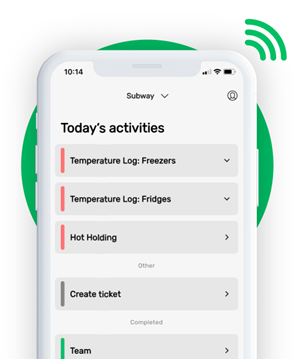US CUTTING BOARD COLOR CHART | FREE POSTER


This is how our Digital Food Safety platform saves 20% of your time on daily tasks:
- Get upcoming task notifications
- Add data into the app
- Check the status of tasks in real-time

When food safety was still handled on paper, I typically spent a couple of hours per day getting the papers and going around checking or completing tasks… Now I can sit down and it's just all there in one place. It takes me 5-10 minutes.
Ruth B.
Store Manager
US Cutting Board Color Code Chart
Key points covered:
- Food businesses use a color-coding system for cutting boards to reduce the likelihood of contamination.
- There is no one strict color code system. The assigned colors for a type of product depending on the food business team's decisions.
- Although colored and only used for a particular food ingredient, cutting boards must be regularly cleaned and sanitized.
- The most commonly used color-coding system in the US includes the following combinations: white for dairy products, red for raw meats, yellow for raw poultry, green for fruits and vegetables, blue for fish, and brown for cooked meat.
- In addition to avoiding cross-contamination, a color-coding system helps promote food hygiene, food safety compliance, allergen management, and streamlines the kitchen process.
- Other food safety operations, such as handwashing, must be performed to support the objective of using colored cutting boards.
- You can train employees and monitor food safety operations to help control cross-contamination using our smart Food Safety Management System.
WHAT WE'LL COVER:
What are recommended color coded cutting boards?
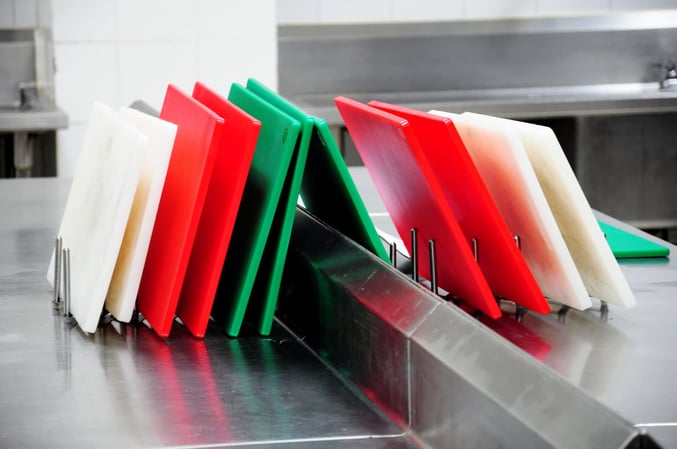
What is the US cutting board color code?
The most commonly used cutting board color code in the US and the corresponding food ingredient they are used on include the following:
- White: Used generally for preparing different types of cheese and other milk products. Includes pastries and baked goods
- Yellow: Used for raw poultry, such as chicken, turkey, and duck.
- Red: Used for raw beef, pork, lamb, and other types of raw meats
- Green: Used for fruits, vegetables, and salads
- Blue: Used for preparing raw fish, shellfish, and other seafood products
- Brown: Used for cooked meat, such as roast beef, burger patties, or ham
Below, we go into more detail about cutting board color codes for different ingredients, answering:
- What color of cutting board to use for raw meat?
- What color of cutting board to use for chicken?
- What color of cutting board to use for cooked meat?
- What color of cutting board to use for fruits and vegetables?
- What color of cutting board to use for raw fish and seafood?
- What color of cutting board to use for baked products and dairy?
A cutting board color coding system is more of a voluntary scheme than a rule. The US Department of Agriculture (USDA) and the US Food and Drug Administration (FDA) only recommend using separate cutting boards to prepare raw ingredients and cooked foods.
Although not a rule, the cutting board color code is a universally used system for ensuring that products are always prepared safely and away from potential contamination of food.
Use our free, downloadable Cutting Board Chart at the beginning of the article to guide your team on which flexible cutting board to use when preparing foods.
What color is the best cutting board for raw meat?
The generally used color of cutting board for raw meat is red. Raw meats are known to contain a wide range of pathogens in food and can potentially cross-contaminate other food ingredients. Using a dedicated cutting board and knives is the most effective preventive control for cross-contamination among ingredients.
Although a red cutting board is dedicated to handling raw meat, this does not mean the board will not have to be cleaned. After every use, raw meat cutting boards must be properly cleaned with hot, soapy water and sanitized.
What color is the best cutting board for chicken?
A yellow cutting board is commonly used to prepare raw chicken and poultry products. Raw poultry contains a different set of target foodborne biological hazards from other raw meats.
Raw chicken and other poultry meat require a higher internal cooking temperature of around 165°F (74°C) when compared with other types of meat. Other types of meat can be cooked to a lower internal temperature such as beef and pork. Therefore, preparing raw chicken requires a separate cutting board.
What color cutting board to use for cooked meat?
When preparing cooked meat, the recommended color is a brown cutting board. Cooked meat products are often cut when prepared for plating.
Cooked meat products such as steaks and lamb chops are sliced before serving for a better presentation.
What color cutting board for vegetables and fruit?
You are recommended to use a green board when preparing fruits or vegetables. Green chopping boards are almost universally used for preparing fresh produce.
Although only one color is dedicated to both fruits and vegetables, the cutting board must still be cleaned in between use to prevent cross-contamination. Leafy greens are considered high-risk products and are linked as common sources of foodborne illnesses when unwashed.
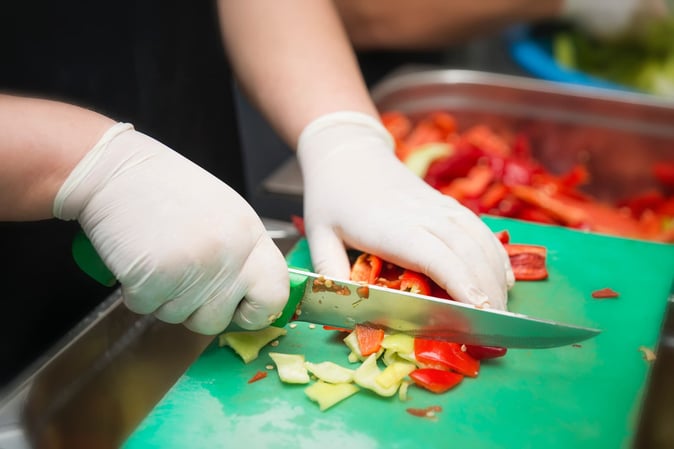
What's the best color cutting board for fish?
You should use a blue cutting board when preparing raw fish or other seafood products. Blue industrial cutting boards provide a clear visual cue that helps to prevent cross-contamination, making it easy to identify the correct board for this particular task.
Another benefit of using a blue cutting board is that it can make it easier to spot any remaining scales or food residues, which can be more difficult to see against a darker surface.
What's the best color cutting board for baked products and dairy?
In general, a white cutting board is often used for preparing baked products and dairy. This recommendation is often debated as some experts mention the need to use separate boards for baked products and dairies, like cheeses and butter.
Use one dedicated cutting board if all of your baked products have dairy in them to prevent both cross-contact and cross-contamination.
In general, it's important to note that this color-coding system is flexible and can be customized according to your team's choice. The main idea is to use dedicated tools and kitchen utensils for raw and cooked products to prevent contamination by different food safety hazards.
Why is using different cutting board colors important?
Using different colors for commercial kitchen cutting boards is a critical control step in any food business that handles both raw and cooked foods. Different colors are used to designate specific types of food, such as raw meat, poultry, seafood, produce, cooked meats, grains, and baked goods.
Specifically, the importance of using a cutting board color code includes the following:
1. Prevents cross-contamination. The color-coding system for cutting board sets helps to minimize the risk of harmful bacteria spreading from one type of food to another that can cause foodborne illnesses.
2. Prevents the spread of food allergens. Using dedicated commercial cutting boards helps your team manage food allergens and protect your customers from allergic reactions.
3. Easy identification and organization. Using different colors of cutting boards helps your employees easily identify essential tools to use without the risk of cross-contamination.
4. Improves food safety. Using a color-coding system is part of proper food safety practices. It highlights the necessity of cleaning and sanitizing kitchen tools, along with proper handwashing and employee hygiene.
Download our Free Proper Handwashing Poster to guide food handlers on how to wash their hands properly.
5. Contributes to food safety regulations compliance. Although a color-coding system is not an official regulation for most countries, using the system helps in complying with strict regulations related to cross-contamination issues.
Despite its effectiveness, your team of food handlers must always remember that the system is not zero-risk. This means that other supporting food service operations must still be done to remove the likelihood of cross-contamination in a kitchen completely.
Ensure that your food safety team is always on top of food safety compliance using our smart Food Safety Management System at FoodDocs.
Our digital solutions can automatically generate customizable digital monitoring logs and checklists to help your team monitor the proper use of colored cutting boards and facilitate their cleaning and sanitation.
Start your food safety compliance journey with a free 14-day trial:
What are the risks of not maintaining proper cutting board colors?
The main risk associated with not using proper cutting board colors is the likelihood of spreading foodborne illnesses.
Cutting boards are used to prepare high-risk food products and ready-to-eat foods. Using the same cutting board for both types of products can spread unwanted pathogenic microorganisms around the kitchen.
Ready-to-eat foods do not require further cooking before serving to customers. They can still be prepared using cutting boards for presentation or rescaling of portions.
The most important reason to properly clean a cutting board and using different cutting board colors is that it promotes safe working conditions for food businesses and highlights the importance of food safety. Preventing cross-contamination is one of the major rules under the 4 Cs of food safety.
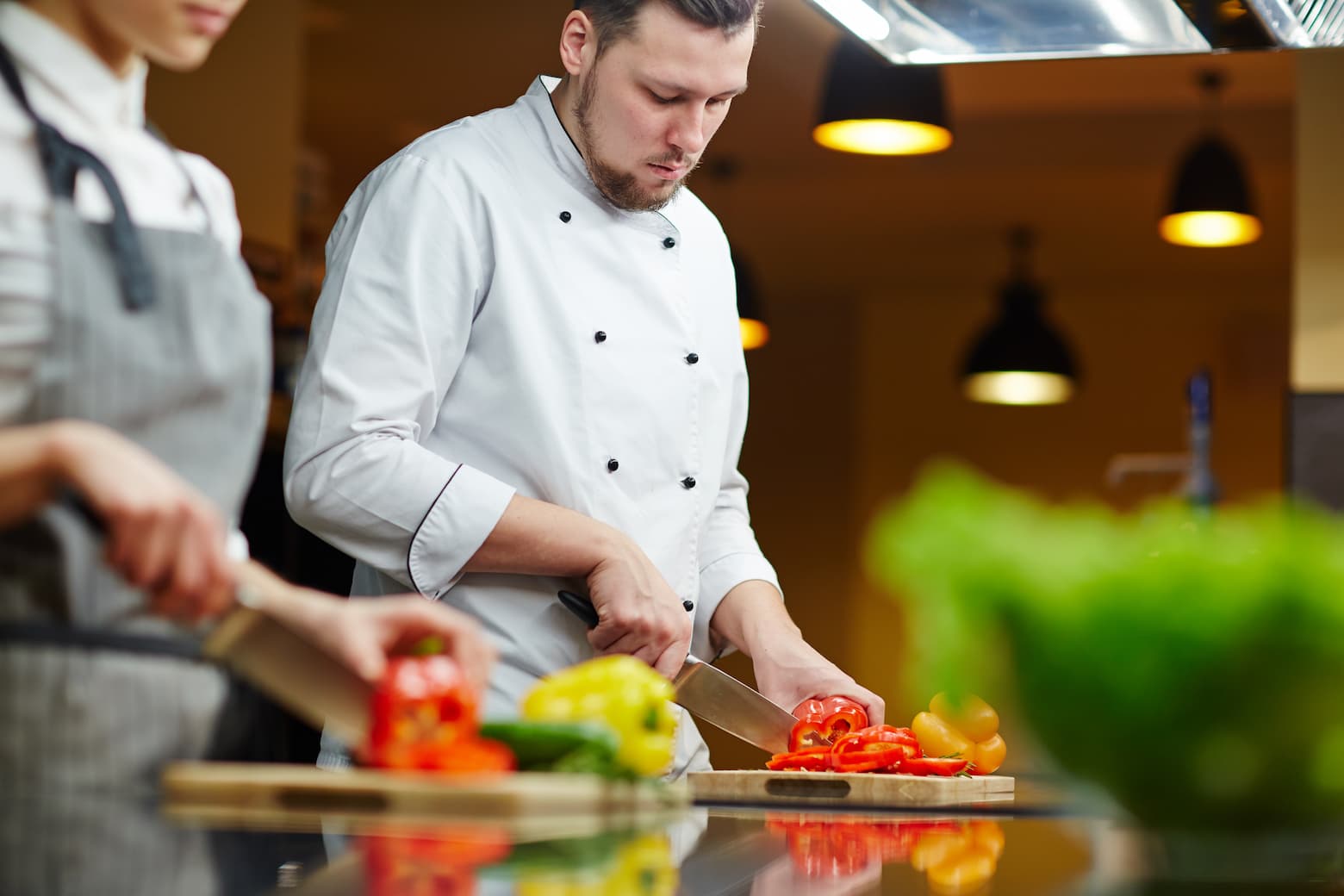
9 Tips for using cutting boards
In addition to using color codes on cutting boards, care must always be practiced when using these tools in the kitchen.
Here are some tips for using cutting boards that can help ensure food safety and prevent cross-contamination in prep areas:
- Clean cutting boards thoroughly after use, even if you use them for the same type of food.
- Avoid using abrasive cleaning solutions and tools. These items can create scratches on the cutting surface, which can become hiding places for food particles and microbial contamination.
- Practice proper sanitation of cutting boards. Use cutting board care supplies suggested by the manufacturer.
- Separate cutting boards are dedicated to preparing foods free from allergens from the rest of your cutting boards.
- Use easy-to-clean materials, such as non-slip plastic cutting boards, to reduce the likelihood of food safety issues and accidents.
- Replace worn-out cutting boards. The likelihood of chipping and physical contamination increases when using old cutting boards.
- Pair dedicated knives with color-coded cutting boards.
- Avoid stacking color-coded chopping boards.
- Follow other food safety rules in the kitchen in addition to using color codes on cutting boards.
Use our free Downloadable Restaurant Cleaning Checklist to get a more comprehensive list of tasks needed in a restaurant and maintaining a clean working environment.
How to use FoodDocs to monitor cutting board color coding in the food safety system
Strict monitoring and proper guidance documents are essential in implementing a chopping board color coding system. Having instructional references and monitoring logs can help your team always keep in mind which colors to use for an ingredient and ensure proper pre- and post-operational cleaning.
At FoodDocs, we understand how important precise instructions and monitoring logs are. Our digital Food Safety Management System includes features to help you in using color codes for cutting boards.
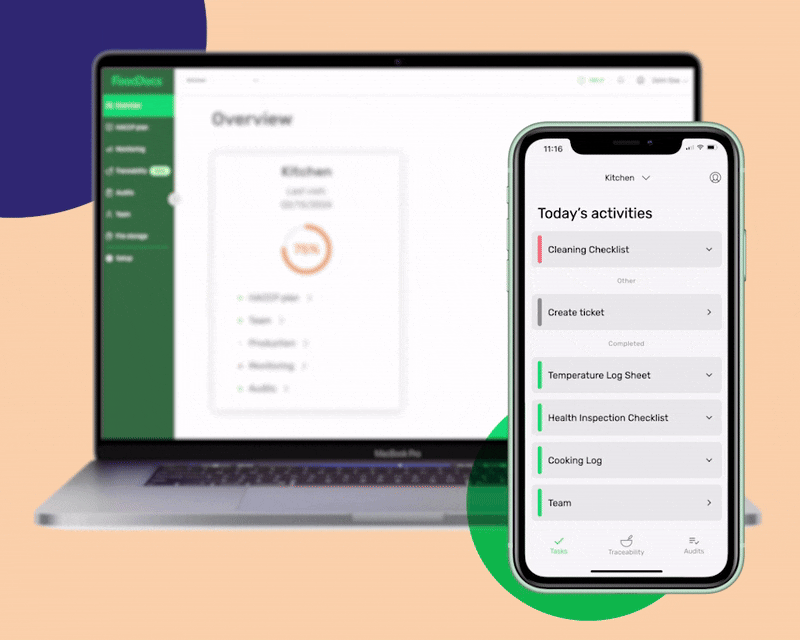
Powered by artificial intelligence and machine learning, our system can provide the following features for your team:
- Get automatically generated customizable monitoring logs and checklists to help your team maintain food safety compliance. Some of the logs and checklists that you can get for food safety compliance include the following:
- Master sanitation schedule. Use this digital schedule to keep track of daily, weekly, and monthly sanitation tasks.

-
- Sanitation and cleaning checklist. Use our sanitation and cleaning checklist to guide food handlers on how to clean and sanitize key areas in your facility properly. The checklist includes the essential daily tasks to maintain food safety.

-
- Employee hygiene checklist. Use this checklist to guide your employees on the essential personal hygiene tasks needed to protect your consumers from foodborne illnesses.

- Each generated monitoring log and checklist features detailed and educative instructions on performing the tasks and preventing food safety issues in the process. You can also upload your own versions of instructions in image or video formats to make the process more tailored to your business.
- Manage food allergens when you upload your product recipes and create your digital Recipe Book in our system. Learn which dishes should be prepared using the dedicated cutting board for foods with allergens, as our system highlights which products have allergenic ingredients. The information is presented in an allergen matrix consisting of your menu items and present food allergens.
- Ensure that every hygiene task is done on time with our mobile app's intelligent notification system. This feature alerts your employees of tasks that need to be done.
In addition to features that ensure food safety compliance, our smart software can also help managers improve efficiency monitoring.
- Set up your own digital Food Safety Management System in just 15 minutes. Simply answer a few basic questions about your operations, and our system will generate all the essential food safety tasks for you.

- Monitor your operations remotely using our software's real-time dashboard. Using this feature, you can easily identify your team's progress and pinpoint any area that requires extra attention across your branches. Save at least 20% of your time supervising your team using our real-time dashboard.
- Store all digital food safety documents in one cloud storage. You can access any digital document from this area at any time, especially during a food safety inspection, and make the process more efficient.
Our smart software was built to make food safety compliance easier and more accessible for all types of food businesses. Using our system, it is easier to facilitate tasks, such as using colored cutting boards.
You can further improve and tailor our intuitive Food Safety Management System according to your operations, as it can be customized with just a few clicks. Incorporate your company's unique food preparation tasks into the generated monitoring forms and checklists.
Experience how our smart software can help you maintain compliance using our free 14-day trial now.
Frequently asked questions (FAQs)
Do you still have questions about this topic? We gathered some of the most common questions about the cutting board color codes and answered them for you.
What is the 5-color coding system of chopping boards?
The 5-color coding system of chopping boards includes white, yellow, blue, green, and red. Each color is dedicated to preparing a particular type of food ingredient or product.
What are the color codes for cutting boards?
Color codes for cutting boards vary from one location to another, but the generally used color code include the following:
- Brown for cooked meat
- Red for raw meat
- Yellow for raw poultry
- Blue for raw fish and seafood
- Green for fruits and vegetables
- White for dairy products and baked goods
What is each color of cutting board used for?
Each color of cutting board is used for a specific food group, and the designated food group may vary depending on the decision of a food business. Commonly, red is used for raw meats, yellow for raw poultry, brown for cooked meats, white for dairy products, blue for fish and seafood, and a green cutting board for vegetables and fruits.
What is the best color for a cutting board?
There is no one "best" color for a cutting board, as the color you choose will depend on your specific needs and preferences. However, it is important to use a different color cutting board for each food group to prevent cross-contamination and ensure food safety.
